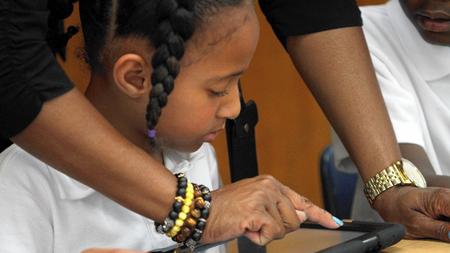
Los Angeles school district officials have allowed a group of high schools to choose from among six different laptop computers for their students — a marked contrast to last year’s decision to give every pupil an iPad..
Contracts that will come under final review by the Board of Education on Tuesday would authorize the purchase of one of six devices for each of the 27 high schools at a cost not to exceed $40 million.
In the fall, administrators, teachers and students at those schools will test the laptops to determine whether they should be used going forward.
What they learn will affect the future of an ongoing effort to provide computers for all students in the nation’s second-largest school system.
“We had the right urgency, but urgency can be the enemy of necessary scrutiny,” said school board member Steve Zimmer. “Now our challenge is to maintain the urgency while getting the details right.”
Districtwide distribution of the iPads is on hold, although some schools still are scheduled to receive them in the fall.
How well the various devices function will be examined by both staff and outside reviewers. Curriculum from three different vendors also are being tried: Pearson; McGraw-Hill/StudySync; and Houghton Mifflin Harcourt.
“Let’s see what works from letting the people in the field — the teachers, the students and the parents — tell us what works,” said Thomas Rubin, a consultant for a committee that oversees the spending of school-construction bonds.
The initial money to pay for the technology is coming from voter-approved bonds. Officials have not yet identified funding to sustain the $1-billion-plus effort. Three of the laptops being tried in the high schools are likely to cost more than the iPads. A different style of laptop, called a Chromebook, would cost less.
Teachers and students at the high schools sent delegations to try out devices and meet with vendors at district headquarters.
It wasn’t a perfect process. The curriculum, for example, was hard to assess in a process akin to speed dating, said one participant.
The laptop options impressed Carolyn McKnight, the principal at East Los Angeles Performing Arts Magnet, one of five schools at the Torres complex. Two chose the Lenovo Yoga Touch, two the Microsoft Surface Pro 2 and the last, a Dell Latitude E7240.
A few other campuses chose Chromebooks.
“The Surface is really sexy, but I was concerned about the detachable keyboard, about students losing or breaking it,” McKnight said.
Some of the devices are hybrids, combining features of a touch screen tablet with traditional strengths of a laptop, such as multiple ports and the ability to run several programs at once.
The deadline for making selections was Friday. McNight chose the Lenovo for her school. She liked being able to flip the screen to the other side for use as a camera, and the option of writing on the screen with a stylus.
McNight hadn’t been as impressed with the iPad, which many of her students used for taking new state standardized tests in the spring. The school also had some older laptops available for the exams.
“Students were more comfortable on the laptop because of the amount of writing and the size of the screen,” she said. “It was really hard to see the whole problem on the iPad.”
Final prices for the devices were being worked out in negotiations last week.
The upcoming trial received praise from some members of the panel that oversees bond spending. This panel clashed at times with senior officials over the iPad contract.
“We are pleased that they are looking into options … to do the best job and get the most for the money,” said committee member Barry Waite. “It’s never good to be stuck to one technology or device.”
By: Howard Blume
howard.blume@latimes.com
Twitter: @howardblume
Source publication: Los Angeles Times